|
BACKGROUND
PARABLES AND THEIR MEANINGS
The
full background to this teaching is available online at this link
Read Background Here
|
Online links to scriptures (New International Version [NIV] unless otherwise stated) are shown in blue
| JEWISH RELIGIOUS FESTIVALS – FOLLOWING THE CYCLE OF THE HARVEST |
|
|
| CIVIL AND RELIGIOUS CALENDARS |
|
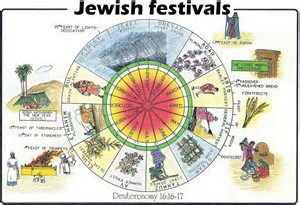 Israel has two calendars, Civil and Religious, starting 6 months apart. This brings confusion when it comes to understanding the timing of events in the Bible, so we need to know which calendar is being used, in order to see how things fit together. Israel has two calendars, Civil and Religious, starting 6 months apart. This brings confusion when it comes to understanding the timing of events in the Bible, so we need to know which calendar is being used, in order to see how things fit together.
Added to this, unlike most countries at latitudes further north or south where annual crops are grown over the summer, cropping in Israel is centred round the relatively cooler and wetter winter months.
The seasons too, follow the Northern Hemisphere pattern, summer coming in the middle of the now generally used Gregorian Calendar Year.
Their annual crops, in earlier days primarily wheat and barley, were planted in the late autumn at the beginning of the Civil Year. Grown over winter they were harvested in spring in the case of barley and early summer for the longer maturing wheat.
The 3 primary festivals of the Religious year, which all men were required to travel to Jerusalem to attend, followed the pattern of the seasons and the harvest. Part of the Feast of Passover, the sub-feast, Feast of First Fruits (Bikkurim), is a celebration of the first of the annual crops, the quick maturing barley, harvested in April/May. God was to be offered the first of the harvest both then and now. From my experience as a commercial grower, the first is usually the best of the crop as well. The men had to return again 50 days later to celebrate the maturing of the more desirable wheat. Wheat is harvested over June/July, with the Feast of Weeks (Shavuot) or Pentecost ('Pente' meaning fifty) as we now know it, celebrating this.
Towards the end of the hot, dry summer and into early autumn, the traditional, delicious, permanent ‘summer fruit’ crops including olives, figs and grapes matured. They were harvested during September/October. This led to the final celebration of the Religious Year, the Feast of Tabernacles (Sukkot), at which time the people gave God thanks for His provision throughout another year.
The Civil Calendar (Genesis 1 – Exodus 11) closely follows the agricultural cycle, beginning with the month of Tishri, in late Autumn, when planting commences, ending in early Autumn, at fruit harvest time.
The Religious Calendar, which the Lord gave to Moses after the Israelite’s escape from Egypt, (Exodus 12 onwards) commences in the 7th month of the Civil Calendar, with the month of Nisan. It is spring, the natural season of new beginnings. It’s also the month of Passover, the first of the religious festivals, celebrating the new beginning for the Israelites after their captivity in Egypt. For us too, as Christians, the death and resurrection of Jesus at Passover time represents a new beginning, the change from Law to Grace. The opportunity to be restored into a relationship with God through the death of Jesus, the final sacrifice on our behalf.
|
| WHEAT AND BARLEY |
|
 The two staple cereal crops in biblical times were barley and wheat, as indeed they, and in particular wheat, are in much of the world today. The two staple cereal crops in biblical times were barley and wheat, as indeed they, and in particular wheat, are in much of the world today.
Great religious significance was placed upon the bounty they provided throughout the Old Testament, with Jesus himself using them to illustrate a number of aspects about the Kingdom of God, including of course, the Parable of the Sower.
|
|
|
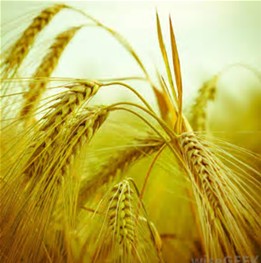 BARLEY BARLEY
Barley is a coarser grain than wheat, with a long ‘beard’ which is hard to separate out from the grain. The beard was used as fodder for horses and cattle, even though its sharp strands could sometimes get stuck in the animal’s mouth. Barley grain was also used for making bread. As it was cheaper and less desirable than wheat, it was looked on as poor people's food. It had advantages over wheat though, in that it matured more quickly and could be grown in poorer soils.
On both occasions when Jesus multiplied the loaves and the fishes, barley bread was used.
Spiritually, barley can be seen as a type of the resurrection of Jesus, the ‘firstfruits’ of the Harvest to follow. The first harvest, the annual barley crop was of course, the reason for the Feast of Firstfruits. Significantly this is celebrated on the exact day Jesus rose from the dead, 3 days after the Feast of Passover, when He died. Surely not a co-incidence!
|
|
|
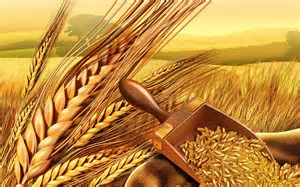 WHEAT WHEAT
With the possible exception of rice, wheat is the world’s most popular cereal crop and definitely its most valuable. The universal use of bread, mostly made from wheat, signifies the huge importance of this crop to us.
Wheat has a great flavour and its short beard makes it easier to separate out the grains from the heads in the threshing process. It takes a little longer to mature than barley, so the wheat harvest is celebrated 50 days after ‘Firstfruits’ at the Feast of Pentecost (Weeks). We, of course, relate Pentecost to the outpouring of the Holy Spirit on that day. Jesus too, likened himself to a grain of wheat. The seed must ‘die’, be planted and grow again, in order to produce a crop. The comparison is striking.
In general though, the wheat crop is seen as an illustration of the harvest of souls into the kingdom, again shown in our parable.
|
|
|
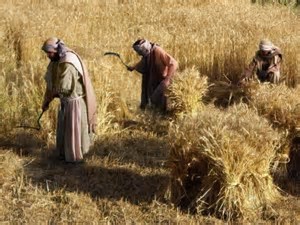 THE HARVEST THE HARVEST
Barley and wheat are harvested in slightly different ways. The harvesters, or reapers, would grab the standing grain in one hand and cut it near the top with the sickle they held in the other. Because barley stalks are used for horse and cattle fodder, the whole plant was then generally pulled out by the roots.
With wheat though, the remaining stalks were left for sheep, goats and cattle to graze at a later time. The cut ends of the stalks were tied into bundles and left out in the fields to dry. Once the moisture was removed and the grains had turned a golden brown, the sheaves were taken away to the threshing floor for further processing.
As part of God’s ‘social welfare system’ the poor were allowed to follow the harvesters through the fields and pick what was missed. Also to harvest grain from the corners of the field, deliberately left for them. This was made famous by Ruth, when she gleaned in Boaz’s fields. (See A Revelation of…Thee Book of Ruth)
|
|
|
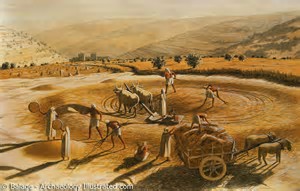 THRESHING AND WINNOWING THRESHING AND WINNOWING
This age-old process was perpetuated in Jordan and Syria right through until the mid-1980’s.
Sheaves of grain were spread out over the threshing floor. This generally consisted of a flat area of exposed bedrock surrounded by a low wall of fieldstones. A threshing sledge was made of wood, approximately 3 metres long, a metre wide with an upturned front like a toboggan and embedded with metal spikes or sharp stones on the bottom. This was used to crush the stalks and release the kernels from the husks. A draft animal would pull the sled, heavily loaded with weights, back and forth over the grain. Once threshed, the winnowing process could begin.
For efficient winnowing, the threshing floor would ideally be located at a high spot exposed to afternoon breezes. At this time, an open-ended tent would be erected to funnel the wind more efficiently. Taking a shovel you would throw the grain into the air. The lighter chaff would float away on the wind, while the heavier, denser grain fell more or less straight down. Having disposed of the chaff you then closed up the open ends and slept there at night to protect the grain from theft. Crop protection was the reason Boaz was sleeping out at the threshing floor when Ruth was sent out by Naomi to lie with him.
|
| GROWING THE BEST CROPS |
|
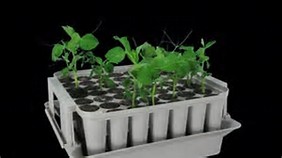 There are 4 primary factors affecting the production of an optimum harvest. There are 4 primary factors affecting the production of an optimum harvest.
THE BEST SEED
Ask any farmer or horticulturist about the importance of planting good seed and they will quickly tell you that seed quality plays a huge part in the crop produced. Hence today, we find huge resources being put into hybridizing and developing new seed strains to produce greater and greater crops. The controversial field of genetic engineering too, has found its first and major application in the modification of seeds, in an endeavour to grow larger, pest and disease resistant, more easily grown, crops.
As a former horticulturist and floriculturist, I spent often seemingly exorbitant amounts of money to purchase the best seed available in order to produce the best crop I could. It's truly amazing the difference quality seed makes.
THE SOIL
As Jesus so rightly points out in this parable, soil quality too, is a huge determinant of crop success. Growing crops in unsuitable soil types is an almost certain guarantee of failure. Fortunately, soil conditions that favour one crop are anathema to another, so there is a wide variety of crops available, to suit many different soil types. Sometimes we can adjust the soil quality for a particular crop, but only in a limited way. But growing the wrong crop for the soil is an almost certain guarantee of failure.
CROP CARE
While we can have good seed and great soil, if we don’t feed, water, weed and generally look after our crop’s ongoing growing requirements, our crop will fail, or at least not do as well as it should. Good husbandry is as necessary for plants to grow well as is taking good care of our bodies for us to be healthy and strong. Except for weeds of course, which seem to thrive in all conditions! Blame that on Adam and Eve!
ACTS OF GOD
One of the challenges of horticulture, and farming in general, is coping with and accepting the unexpected. For nature, for God, is simply greater than us. Even though we often try to deny it! It's not surprising then, that those who work on the land are, on average, more spiritually aware than city dwellers. For they can see, and are directly affected by, a greater power than themselves at work, every day. Rain, hail and snow, floods, storms and drought, sun, cloud, heat and cold, all affect crop performance, often dramatically.
Yes, the might of God is reflected in so many things that are simply beyond our control. Whatever we do, however careful and skilled we are, the fruit of our labour can be wiped out in a moment. Such is the awesome power of God.
|
| <i>NEXT WEEK:</i> A REVELATION OF…….THE PARABLE OF THE SOWER continues.....
|
|
 As we start our consideration of the parable itself. As we start our consideration of the parable itself.
|
| A NOTE FROM DAVID |
|
An understanding of Jewish agriculture and it's cycles helps us greatly in understanding the Bible. For the Bible is the story of a people whose very existence was determined by agriculture, in a way that city dwellers today cannot comprehend. Society revolved around it!
|
So until next week.......
MAY GOD BLESS YOU AND YOU BLESS GOD!
His servant and yours

Learn more about us at...
www.wwj.org.nz/about.php
|
A DAVID'S DOODLING
190. Forgiveness flies away, a leaf borne by the wind, soon to be returned upon the wings of an angel.
David Tait
|
Check
out the WWJ website for….
More David's Doodlings: www.wwj.org.nz/dd.php
Laughing at Ourselves: http://www.wwj.org.nz/laugh.php
A look at some of lifes curious questions: http://www.wwj.org.nz/why.php
Everything you ever wanted to know about....: http://www.wwj.org.nz/exex.php
Life's a Laugh: http://www.wwj.org.nz/lifelaugh.php
|

 Israel has two calendars, Civil and Religious, starting 6 months apart. This brings confusion when it comes to understanding the timing of events in the Bible, so we need to know which calendar is being used, in order to see how things fit together.
Israel has two calendars, Civil and Religious, starting 6 months apart. This brings confusion when it comes to understanding the timing of events in the Bible, so we need to know which calendar is being used, in order to see how things fit together.  The two staple cereal crops in biblical times were barley and wheat, as indeed they, and in particular wheat, are in much of the world today.
The two staple cereal crops in biblical times were barley and wheat, as indeed they, and in particular wheat, are in much of the world today. BARLEY
BARLEY WHEAT
WHEAT  THE HARVEST
THE HARVEST THRESHING AND WINNOWING
THRESHING AND WINNOWING There are 4 primary factors affecting the production of an optimum harvest.
There are 4 primary factors affecting the production of an optimum harvest.  As we start our consideration of the parable itself.
As we start our consideration of the parable itself. 